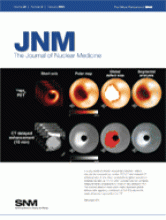REPLY: Dr. Fisher makes several important points in his letter to the editor regarding the findings in our publication on 18F-FDG PET in evaluation of solitary pulmonary nodules (1). As with any diagnostic test, PET in this application will be most useful when it is likely to change or modify the management approach. The ability of the test to do this depends on the likelihood of disease before the test—the disease prevalence—and the test performance characteristics. These factors then determine how we should decide who could benefit from a PET study and once the test has been performed how the result could influence management. Given the excellent performance parameters that we identified—a likelihood ratio of 9.9 for a positive PET read as “definitely malignant” and a likelihood ratio of 0.03 for a negative PET read as “definitely benign”—it is still unlikely that patients with either a very low (5%) or very high pretest probability (>80%) of a malignant solitary pulmonary nodule would benefit from this examination (2). In a cost-effectiveness analysis of 18F-FDG PET in solitary pulmonary nodules, Gould et al. reached similar conclusions and indicated that 18F-FDG PET should be used selectively when pretest probability and CT findings are discordant or in patients with intermediate pretest probability who are at high risk for surgical complications (3). They note importantly that the cost-effectiveness of various diagnostic strategies depends critically on the pretest probability of malignancy.
The strength of the evidence required before a management decision is made will vary depending on the pretest likelihood of disease and the risk of a specific intervention. As Dr. Fisher indicates, a negative predictive value of a nodule with no uptake (i.e., “definitely benign” by our criteria) is 97% and is probably acceptable for adopting a watch-and-wait strategy, but a negative predictive value of a “probably benign nodule” (estimated standardized uptake value > 0.6–0.8 but < 1.5–2.0) is 87% and may not be convincing enough to avoid a biopsy, especially in a patient with a smoking history and other risk factors for malignancy (2). Although we dichotomized the 5 confidence levels of interpretation as described for determining sensitivity and specificity, we did develop interval likelihood ratios for each level of interpretation. In this regard, with our prevalence rate of 53% malignant nodules, a patient whose nodule was rated definitely benign by PET had a posttest probability of malignancy of only 3% as pointed out by Dr. Fisher. Similarly, a patient whose nodule was rated probably benign by PET had a posttest probability of 13%. In populations with lower prevalence rates, the pretest–posttest probability decrease would be shifted even further. For example, in a population with a 20% prevalence of malignancy, the posttest probabilities would be reduced to 1% and 4% in patients with definitely benign and probably benign interpretations, respectively.
We strongly agree with Dr. Fisher about the hazards of continuing to consider a binary cutoff of 2.5 for standardized uptake value as capable of reliably distinguishing benign from malignant nodules. We would instead encourage the adoption of a visual scoring methodology with a validated, more continuous scale that relates to interval likelihood ratios, such as described in our publication. In this manner, the clinical pretest likelihood of malignancy could be incorporated into the final estimate of the posttest likelihood of a malignant or benign nodule.
Footnotes
-
COPYRIGHT © 2009 by the Society of Nuclear Medicine, Inc.







